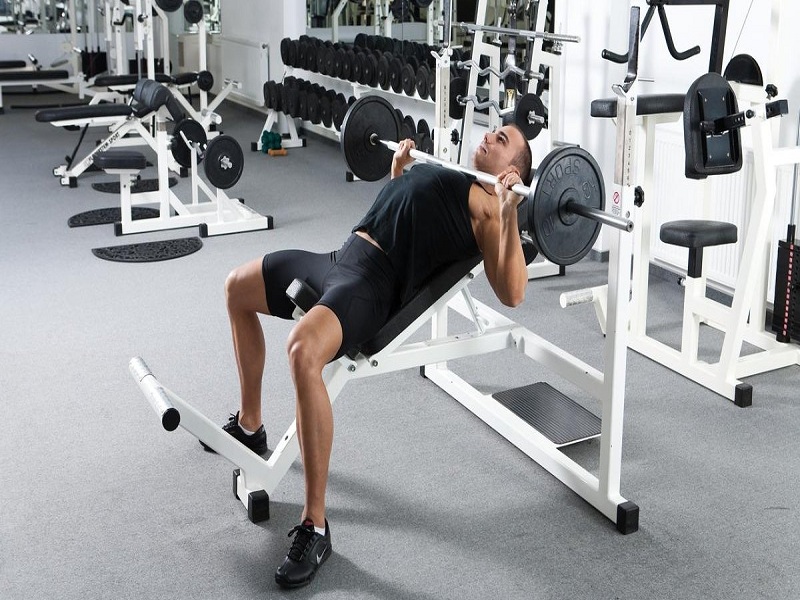You’re probably bench pressing if your goal is to develop your chest muscles. Workout enthusiasts of all fitness levels utilize this as their go-to chest workout. It benefits them in their daily routine. The incline bench press workout is your best option if, on the other hand, you feel that the tops of your chest don’t get enough attention. Thus, an Incline Bench Press Angle is the best workout.
What is the incline bench press angle?
An incline bench press is horizontally lifting the best types of workout. It is in which you lie on a board. It is tilted so that your upper body and head are level. You press dumbbells away from your chest. The muscles that the incline bench press targets are the pectoralis major (breast muscles), biceps, and anterior shoulder musculature. In this workout you will also employ your upper trapezius muscles and core to balance your body.
Overview of the workout:
An activity for developing the chest muscles is the incline bench press, a version of the bench press. Moreover, work with the triceps and shoulders. By an incline, targeting the upper chest is often neglected by bodybuilders. Your chest build training, entire torso workouts, push strength exercises, and complete body workout sessions can involve incline bench press exercises.
Purpose of Incline bench press:
The incline press goal is to concentrate more of the exercise on the upper pecs. The higher pectoralis major is the benefit of executing incline presses. You engage your shoulders because it’s similar to a shoulder press, when the bench is inclined (15 to 30 degrees). Although, the incline bench press is an excellent muscle-building exercise. There are drawbacks to the lift. The muscles employed in different pressing exercises are also involved when incline bench pressing.
Advantages of incline bench workout:
These are the following:
Strengthens the Abdominal Muscles
The sternocostal head and cephalic head are two significant muscle fibers. Heads make up the pectoralis major, the major muscle of your chest (upper chest). In a typical, balanced bench press, the sternocostal head is the muscle that contracts. At the shoulder, attach the pectoralis major’s clavicle head. Its use is lifting your right forearm.
Less strenuous on the shoulder
Bench pressing is a high-reward workout that leads to the bursting of the pectoralis major. Also, it’s linked to other injuries, such as “bench presser’s shoulder,” which harms the shoulder joint. The incline bench press angle can be an ideal compromise if performing upper lifts. It strengthens the shoulder without causing you a shoulder ache. You’ll experience this when training on a flat bench or doing an overhead press. It is because it targets the anterior deltoid more than the flat bench press does.
The Movement is Complex.
In contrast to single-joint movements, compound movements simultaneously target several joints and muscles (like dumbbell curls). Complex exercises will help you save time and energy by training multiple muscles at once during your workouts.
It is Simple to Change
You may adapt this workout by performing the incline press with dumbbells. Try to perform this exercise with a neutral position if you dislike the dumbbells feeling on your shoulders. Moreover, you can have an inverted, alternating dumbbell incline press to increase the difficulty of this exercise. Lower your right hand, push it back up, then drop your left hand while holding both weights above.
The best angle to perform the exercise:
You can use a fixed 30 or 45-degree incline bench to conduct a heavy incline bench press. But if you’re performing this exercise on a movable bench. You can pick your own incline bench press angles. The upper chest region responds well to incline bench press exercises is 30 degrees. If you’re performing this workout on a Miller machine, you might want to tilt your movable bench at a 45-degree angle.
Step-by-step instructions:
- Hands should be longer than shoulder width. It is when lying flat on an inclined bench.
- Pull your shoulders together and press them firmly onto them to set them.
- To keep your lumbar straight, breathe deeply and let your observer assist you with the lifting.
- After lifting off, let the load rest until your upper back is firm.
- Lock the shoulders and breathe as you gradually lower the weight.
- Straighten the rod and lower it until it touches the chest at the base of the sternum (breastbone).
- Continue for the appropriate amount of times.
Mistakes while doing incline bench press:
Utilizing an Incorrect Workbench Tilt
It’s crucial to position the incline bench press at the proper angle when performing the exercise. It helps your front shoulder work less and lets your upper arms work more to expand. According to studies, the incline bench press should be at an inclination of 30 degrees off flat to target the upper chest. Although it may seem like a slight angle, this is the best posture for an incline bench press to target your upper shoulders and arms and minimize the impact on your front shoulder muscles.
Keeping Your Shoulder Squeezed
It is how your shoulders are when you perform a few repetitions on the 30-degree incline bench press. Your shoulders will begin to curve forward when the anterior delt becomes dominant. In this instance, the front is a position about the chest. Compared to your upper chest, it is more noticeable, can move quickly, and can press farther.
Final words:
An exercise for increasing total upper-body strength is the incline bench press angle. It concentrates on the back, neck, biceps, and breasts. It shapes your chest cavity and strengthens it. An inclination bench can also be to target particular chest or shoulder muscles. Your workout objectives will determine whether a 30 or 45-degree incline bench is for you. A 45-degree tilt is ideal for working the upper chest muscles. Whichever choice you select, an incline bench press is a powerful exercise that you can perform from any location.
